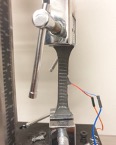ERC Improves Durability of Flexible Thermoelectric Generators for Body Heat-Powered Wearable Devices
Outcome/Accomplishment
The NSF-funded Engineering Research Center (ERC) for Advanced Self-Powered Systems of Integrated Sensors and Technologies (ASSIST) has improved scalable thermoelectric generators (TEGs) that can be integrated into textiles and circuits to create self-powered and wearable monitoring devices. The testing of various materials for durability and flexibility improved overall design functionality.
Impact/Benefits
The use of heat from the human body is a promising approach to creating self-powered, wearable devices that can run continuously. The development of soft, stretchable, and low-resistance materials that can withstand a variety of environmental strains increases the available power and durability of wearable devices powered by TEGs.
Explanation/Background
Flexible TEGs convert the small temperature difference between the body and the environment into electricity to power self-contained circuit systems, like those found in industrial settings, and self-sustaining health monitoring systems.
The NSF-funded research team tested flexible TEGs with Ecoflex fillers, a biodegradable and certified compostable plastic, to improve device performance. The TEGs fabricated with porous Ecoflex fillers matched the performance of TEGs with aerogel doped fillers. In one experiment, all flexible TEGs tested were able to handle extreme amounts of tensile strain before physical failure. The experimental results indicated that the TEGs can tolerate strain levels well over 200%.
Location
Raleigh, North Carolinawebsite
Start Year
Biotechnology and Healthcare
Biotechnology and Healthcare
Lead Institution
Core Partners
Fact Sheet
Outcome/Accomplishment
The NSF-funded Engineering Research Center (ERC) for Advanced Self-Powered Systems of Integrated Sensors and Technologies (ASSIST) has improved scalable thermoelectric generators (TEGs) that can be integrated into textiles and circuits to create self-powered and wearable monitoring devices. The testing of various materials for durability and flexibility improved overall design functionality.
Location
Raleigh, North Carolinawebsite
Start Year
Biotechnology and Healthcare
Biotechnology and Healthcare
Lead Institution
Core Partners
Fact Sheet
Impact/benefits
The use of heat from the human body is a promising approach to creating self-powered, wearable devices that can run continuously. The development of soft, stretchable, and low-resistance materials that can withstand a variety of environmental strains increases the available power and durability of wearable devices powered by TEGs.
Explanation/Background
Flexible TEGs convert the small temperature difference between the body and the environment into electricity to power self-contained circuit systems, like those found in industrial settings, and self-sustaining health monitoring systems.
The NSF-funded research team tested flexible TEGs with Ecoflex fillers, a biodegradable and certified compostable plastic, to improve device performance. The TEGs fabricated with porous Ecoflex fillers matched the performance of TEGs with aerogel doped fillers. In one experiment, all flexible TEGs tested were able to handle extreme amounts of tensile strain before physical failure. The experimental results indicated that the TEGs can tolerate strain levels well over 200%.

